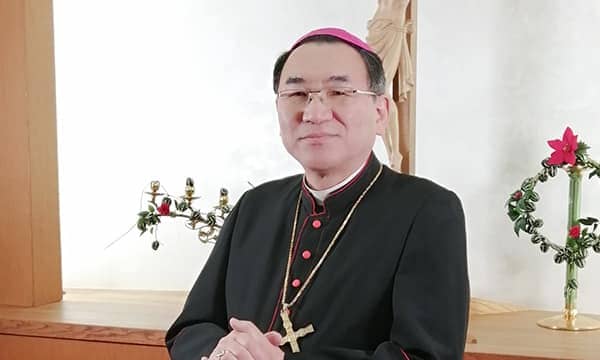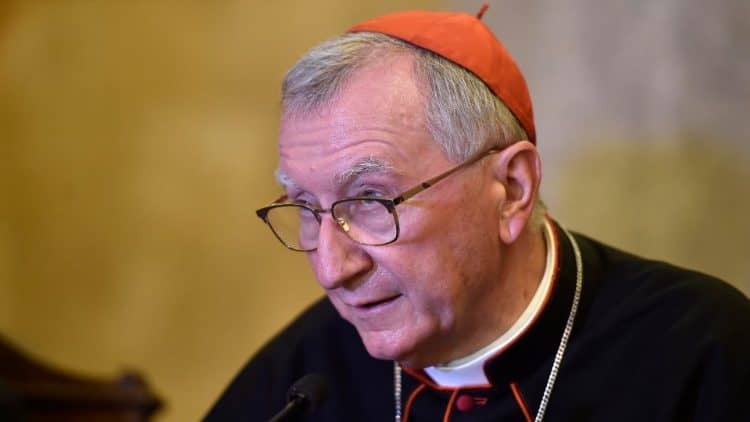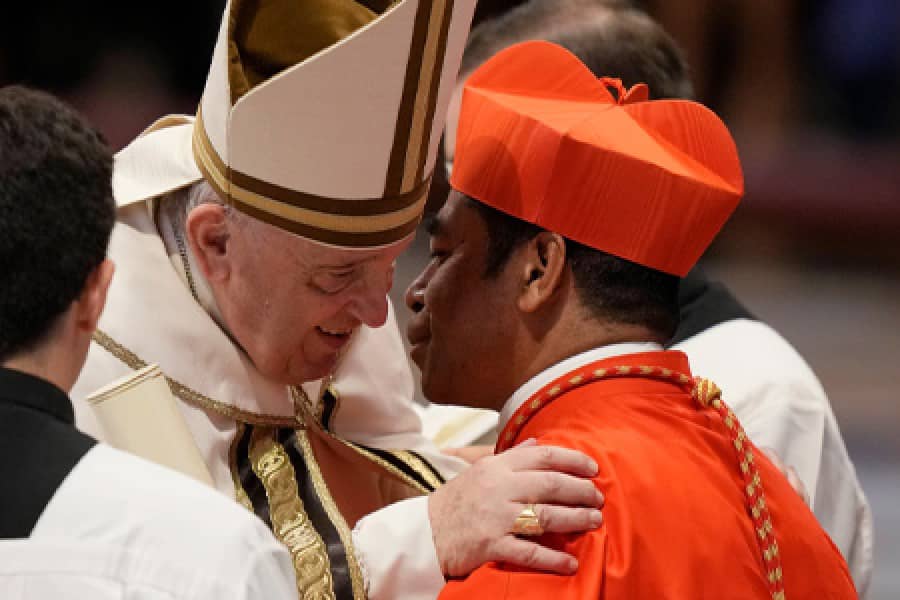MANILA — Some days on a papal trip, there’s no one overarching theme, but lots of interesting twists and side notes. Friday, the first full day of Pope Francis’ Jan. 15-19 outing to the Philippines, felt like such a day.
Here, then, a few sights and sounds of the pope’s Philippines adventure.
‘Pope-mania’
Sort of like a collective Catholic version of Will Rogers, the Filipinos have apparently never met a pope they didn’t like.
They turned out in throngs to greet Pope Paul VI in 1970, and despite the fact he was in the country less than 48 hours, his visit was picked the top news event of the year by a body of Filipino journalists. John Paul II came here twice, in 1981 and 1995, and on the second occasion drew around 5 million people to a Mass, still the all-time record for a papal event.
This time, too, enthused crowds surged through the streets of Manila hoping to catch a glance of the pontiff, dubbed the “People’s Pope” by an adoring front-page tribute on the Philippine Star, a widely read local newspaper.
A columnist summed up popular sentiment by opening her piece with, “How can you not like this pope?”
At times, Francis has even felt forced to try to dial down popular enthusiasm. In the run-up to the trip, the route he was planning to take was festooned with images of the pontiff of every sort, popping up on street lights, storefronts, rooftops — pretty much anywhere a papal banner could be affixed.
Word quietly came down from the Vatican that Francis preferred the focus to be on God rather than himself, so most of the images came down and the route instead simply displayed the Filipino and Vatican flags.
Fears that the frenzy over Francis might turn dangerous are clear in the abundant security measures being deployed, including the use of electronic jammers to block cell phone signals so they can’t be used to trigger bombs.
As of early afternoon on Thursday, cell phones basically didn’t work in any area the pope was likely to pass through, which included large chunks of downtown Manila as his motorcade rolled by.
(As a footnote, the blackout also affected the press corps following the pope, who were basically unable to use their phones for an hour after landing to pass along the news of what the pope had said in an airborne press conference.)
Although it’s still three days away, lots of Filipinos are already preparing for the pope’s open-air Mass in Manila’s Rizal Park on Sunday, an event that many think will draw 6 million people or more, surpassing the record set by John Paul II.
Joan Fernandez, 45, said she and her 16-year-old daughter have been getting ready to brace the long walk and the massive crowds by going to bed early all week to make sure their energy levels peak at the right time.
“It might be more comfortable to watch him on TV, but we want to see him in person,” she said. “It may take another 20 years for another papal visit. I’m not sure I’ll be here then, and I don’t want to miss my chance.”
On Sunday, we’ll know if 5,999,999 other Filipinos feel the same way.
Corruption
Although Francis came to the Philippines in the first place to expression compassion for Typhoon Yolanda in 2013, which killed more than 6,000 people and left more than a million homeless, that doesn’t mean the pontiff isn’t engaging other social and political matters along the way.
The Philippines is a congenial environment for the pope’s social agenda. The bishops here have declared 2015 their “Year of the Poor,” aiming to press both the government and the Church to step up efforts at reaching out to the needy, the marginalized, and victims of oppression.
Friday morning, Francis met President Benigno “Noynoy” Aquino, and then gave a speech to government officials and diplomats. To Filipino ears, one line of that address may stand out: Francis called on public officials to reject “every form of corruption which diverts resources from the poor.”
While that may seem boilerplate rhetoric, here it’s a fairly bold way of pointing out the elephant in the room, since the Philippines routinely ranks as among the most corrupt nations in Asia, and often it takes especially brazen forms.
This is a country, after all, where two former presidents in a row, Gloria Macapagal Arroyo and Joseph Estrada, faced trial on charges of various forms of corruption. Estrada was actually convicted of looting $80 million in public funds and sentenced to life in prison, only to be pardoned by Macapagal Arroyo and run for president again, actually placing second in 2010 to Aquino.
Although the Filipino Church has often spoken out against corruption, it’s not always been enough for everyone’s taste.
In his remarks to Pope Francis on Friday, Aquino recalled the Church’s lead role in the 1980s-era People Power movement that swept Ferdinand Marcos from power, but then accused it of being “silent in the face of the previous administration’s abuses,” referring to Arroyo.
Today, whatever verve was lacking seems to be back. Manila’s Cardinal Luis Antonio Tagle, popularly known as “Chito”, launched an anti-corruption drive last year which featured T-shirts with the line, “Thou Shalt Not Steal!”
In that sense, Francis’ blunt reference will likely be heard as a direct challenge to the country’s political class, perhaps a gentle call on the bishops to keep speaking out, as well as a thumbs-up for Tagle.
As a footnote, it was hard to miss the long embrace between Francis and Tagle at the Manila airport on Thursday after the pontiff’s arrival. More and more, it seems the Argentine pontiff has taken a shine to the young Filipino prelate.
Filipino president takes the Church to the woodshed
The Aquinos are sort of the Kennedy family of the Philippines, meaning the country’s most celebrated political clan. Senator Benigno Aquino Jr. was the staunchest critic of Marcos before being assassinated at the Manila airport upon return from exile in 1983. His widow, Corazon Aquino, would later become president herself, and the country’s current leader is their son.
Also like the Kennedys, the Aquinos are deeply Catholic, but have sometimes had their issues with the hierarchy. On Friday, we heard echoes of those tensions in the remarkably frank speech Aquino delivered to the pope.
He began by recalling that the Church supported the Spanish colonization of the country, saying that when people complained of injustices, the Church would reply, “the Kingdom of God is not of this earth.”
Aquino said much of that intransigence changed during the era of the Second Vatican Council (1962-65), and praised the role many clergy played during the anti-Marcos uprising.
“Especially during the Martial Law years, the Church of the poor and oppressed shone vividly,” he said.
As noted, Aquino complained that prophetic edge seemed to go into eclipse under Arroyo, and said that now all Church leaders seem to be able to do is complain … “even to the extent,” he said, “that one prelate admonished me to do something about my hair, as if it were a mortal sin.”
Aquino praised Francis’ recent speech to the Roman Curia, calling him a “kindred spirit,” and then closed the circle by quoting a George Bernard Shaw line that was a Kennedy favorite too, in this case RFK: “Some people see things as they are, and say why; I dream of things that never were, and say why not?”
Though it’s hardly uncommon for progressive Catholic politicians to occasionally run afoul of various sectors of Catholic officialdom, it’s rare for one to use a papal visit to air those conflicts. No doubt, the speech will be a hot topic in Filipino Catholic circles for a while.
(As a footnote, Aquino also referred to Tagle as a “kindred spirit.”)
Vatican ‘clarifies’ Francis on Paris attacks
Francis stirred controversy before he even arrived in the Philippines with comments aboard the papal plane taken in some quarters as a semi-justification for the Jan. 7 attacks in Paris on Charlie Hebdo, a French satirical magazine.
Twelve people were killed by gunmen shouting Islamic slogans in retaliation for a series of cartoons and essays lampooning Muhammad, the founder of Islam.
Aboard the papal plane from Sri Lanka to the Philippines, Francis was asked by a French journalist about how he sees the relationship between religious freedom and freedom of speech. Recognizing immediately what the reporter was really asking, he replied, “You’re French, so let’s get to Paris, let’s speak clearly.”
The pontiff then said that killing in name of God is always wrong, but also that freedom of speech has its limits. In particular, he said, one should not “provoke,” “offend,” or “toy with” the religious sentiments of others.
Pointing to Alberto Gasparri, a layman who serves as the primary organizer for his trips, Francis said that if even such a “dear friend” were to insult his mother, he’d get a punch in the nose.
Some headlines afterwards spun the story as “Pope Endorses Violence,” forcing the Vatican to walk things back.
“The pope’s expression is in no way intended to be interpreted as a justification for the violence and terror that took place in Paris last week,” a statement released in the wee hours of the morning said.
“His words mean that there are limits to humor and satire particularly in the ways that we speak about matters of faith and belief,” it said.
“The pope’s free style of speech, especially in situations like the press conference, must be taken at face value and not distorted or manipulated,” the statement added.
Frankly, in context it seemed clear enough that Francis did not mean to approve violence, but rather to condemn insulting someone’s religious convictions. That said, it was another example of how his relaxed and informal style may be part of his charm, but often it can also put his spin doctors in an awkward spot.
A bombshell that (mostly) wasn’t
On Thursday, it seemed for a brief moment that the pope’s visit might be marred by a bombshell report in the UK-based Daily Mail about street children being caged and subjected to barbaric conditions in order to make Manila seem more presentable.
It was a gripping story, replete with pictures of anguished and emaciated youth behind bars in appalling conditions. Unfortunately, the only problem is that, according to both government sources and local media reports, it was terribly exaggerated.
The Social Welfare and Development Secretary for the Philippines, Corazón Soliman, told reporters that one of the children pictured in the report is a boy named Federico, who has already gained weight since his picture was taken and is no longer in custody. He’s currently being cared for, she said, by an NGO.
While not denying that some children have been removed from the street by a handful of local government units, she insisted that it’s “a protection measure, not to hide them,” that they will be offered a range of educational and health services, and that they’re not at risk of abuse.
“We put child abusers in jail,” she said.
Soliman also said that the idea is not to try to hide the fact that many Filipino children live in poverty, something that would likely be futile with the street-savvy Francis in any event.
“We’re not hiding the children,” Soliman said. “In fact, more than 400 street children will sing during the send-off for Pope Francis on Monday.”

















